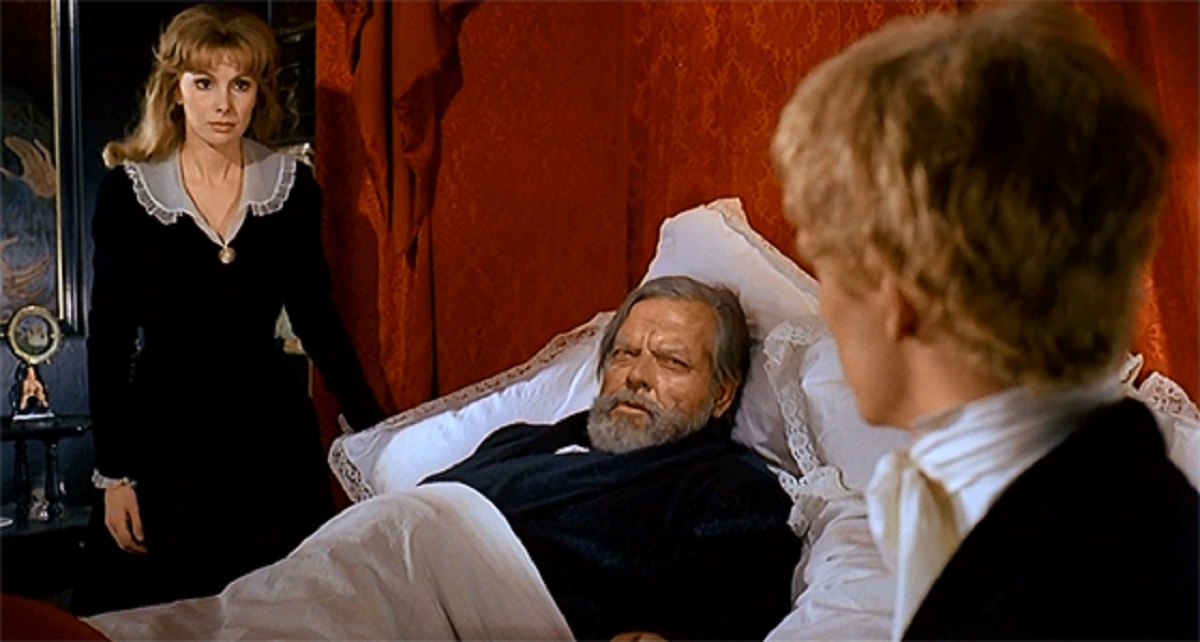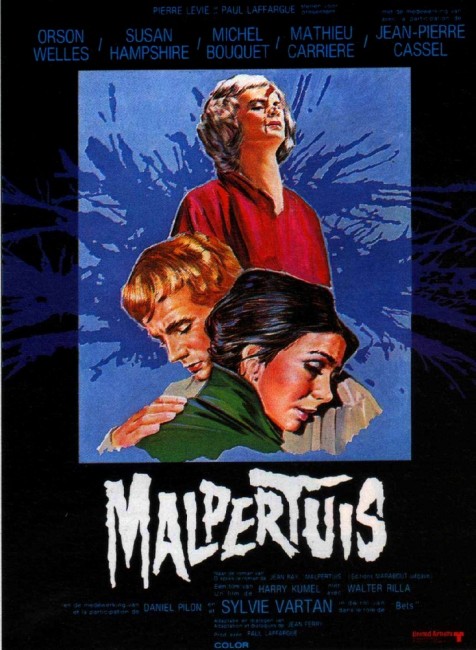Crew
Director – Harry Kumel, Screenplay – Jean Ferry, Based on the Novel Malpertuis by Jean Ray, Producers – Paul Laffargue & Pierre Levie, Photography – Greg Fisher, Music – Georges Delerue, Special Effects – Michel Bernard & Jean Pereviaux, Art Direction – Pierre Cadiou de Conde. Production Company – S.O.F.I.D.O./Societe d’Expansion du Spectacle/Artemis/Les Productions Artistes Associes.
Cast
Mathieu Carriere (Jan/John Van Kramer), Susan Hampshire (Nancy/Alice/Euryale), Orson Welles (Uncle Quentin Cassavius), Michel Bouquet (Charles/Hermes), Charles Janssens (Philarus), Daniel Pilon (Matthias Croak/Apollo)
Plot
Shortly after disembarking in his home port, the sailor Jan is abducted. He comes around in Malpertuis, a large, rambling mansion where he finds that he and various others have been gathered by the dying Quentin Cassavius. Quentin wants them all to inherit his vast fortune equally – on the condition that they remain in Malpertuis the rest of their lives and that the last two marry. After Quentin dies, Jan begins to explore the mansion and grounds. However, as some of the others try to leave, they turn up killed in mysterious ways. Slowly Jan pieces together the secrets of Malpertuis – how those in the household are in fact the Greek gods. Quentin found them abandoned and forgotten on an island and sewed them into human skins – his last wish is for them to mate and produce a new race of demi-gods.
Belgian director Harry Kumel first made an impression with chicly decadent vampire film Daughters of Darkness (1971). Kumel then returned to the genre with this gorgeously elegant art-house contemplation on myth. Though Harry Kumel has been at work as a director since the 1950s, the rest of his work has gained little exposure outside of Benelux countries. Harry Kumel’s other works includes Monsieur Hawarden (1968), a true story about a woman who disguised herself as a man to flee a murder; an adaptation of Rumpelstiltskin (1973); the Magical Realist The Coming of Joachim Stiller (1976); Paradise Lost (1978), which is unrelated to Milton but is a satire of smalltown politics; The Secrets of Love (1986), an anthology of erotic tales; and the period drama Eline Vere (1991).
Malpertuis is an appealingly offbeat reflection on the outmodedness of myth in the modern day. Harry Kumel conducts it with a sublime merging of understated humour, story, colour and set design. The film is designed in the nature of an arthouse mystery – one is constantly reminded of Last Year in Marienbad (1961), although the closest comparison is surely with Mervyn Peake’s Gormenghast saga with its massively rambling and decayed castle world, which was badly filmed as Gormenghast (tv mini-series, 2000).

Malpertuis is a triumph of design. The grounds of Malpertuis are a world of barren, stripped bare woods and vast, decaying abbey ruins, all limned in mist, a world that holds a palpable sense of nothing growing there; the house with askewed spiral staircases that seem to ascend and descend into infinity; madcap laboratories with foetuses in bottles, rickety shelves and straw strewn across the floor; an attic with a rhomboidal infrastructure that trails off into perspective; wonderful names such as The Colour Shop (as to what it actually sells, one is never gets to find out); locked rooms coloured in the most exquisite azure blue drapings; low crimped corridors that twist and turn in strange ways; and even the outside world set among a warren of narrow cobbled streets and 17th Century crown glass windows where strange figures – a boy with one leg, a blind man looking through the window of a shop – lurk. It is a fabulous atmosphere that Harry Kumel has created – one that suggests all manner of secrets, including adulteries and murders, taking place in its shadows.
The cast hold up well, with some of the relative weaknesses – such as Mathieu Carriere’s unvarying expression of perpetual crossness – being buoyed up by Harry Kumel’s atmosphere. The best performances comes from Susan Hampshire who affects a remarkable chameleon shift between her three roles (four, if one counts her appearance as Mathieu Carriere’s wife in the real world scenes at the end) – between Alice the spinster in black who bubbles with repressed passion, the sweet and naive Nancy and the inhumanly beautiful red-haired Euryale. Harry Kumel’s triumph though is to obtain a surprise guest performance from Orson Welles as the patriarch who presides over the strange household.


